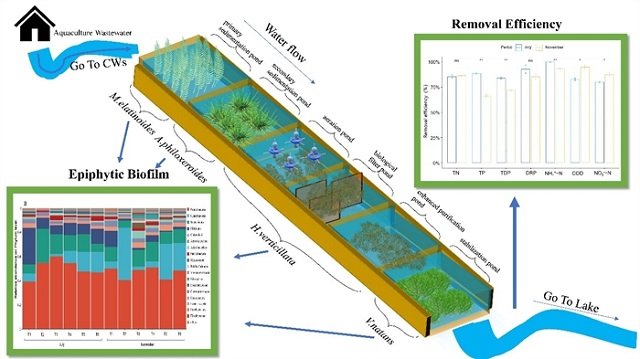
The aquaculture industry faces significant environmental challenges, primarily due to the generation of nutrient-rich wastewater. This wastewater, laden with fish feed residues and excrement, can cause water pollution, eutrophication, and harmful algal blooms. To address this issue, constructed wetlands (CWs) have emerged as a sustainable and cost-effective solution.
To enhance the efficiency of CWs in treating aquaculture wastewater, researchers from the South China Agricultural University, Guangdong Provincial Key Laboratory of Utilization and Conservation of Food and Medicinal Resources in the Northern Region, and Shenzhen Institute of Guangdong Ocean University conducted a comprehensive study to identify the optimal combination of microbial complexes, substrates, and macrophytes. By systematically examining various components, they aimed to maximize nutrient removal, particularly nitrogen and phosphorus.
The Alternative of Constructed Wetlands
Constructed wetlands have emerged as a promising green technology for wastewater treatment. CWs use substrates, plants, and microorganisms to remove contaminants from aquaculture wastewater.
The Study
According to a study published in the Journal of Water Process Engineering, the researchers evaluated four microbial complexes, five macrophytes, and two substrate materials for their ability to remove chemical oxygen demand (COD), total nitrogen (TN), ammonium nitrogen (AN), nitrate nitrogen (NN), and total phosphorus (TP) from aquaculture wastewater.
Key Findings
Microbial Energy
Among the microbial complexes tested, MC3 at a concentration of 1.0 g/L proved to be the most effective in removing a wide range of contaminants, including COD, TN, AN, NN, and TP.
Macrophyte Marvel
Myriophyllum aquaticum (MA) emerged as the highest-performing macrophyte, demonstrating exceptional nutrient reduction capabilities.
Substrate Superiority
Zeolite outperformed ceramsite in terms of nutrient removal efficiency, particularly for nitrogen compounds.
A Synergistic Approach
Based on these findings, the researchers developed four artificial CWs, each incorporating the optimal components identified in the study.
Stay Always Informed
Join our communities to instantly receive the most important news, reports, and analysis from the aquaculture industry.
The study’s results revealed that the CW-2 system, which combines MA, Canna indica, MC3-T2, and zeolite, achieved the highest removal rates of COD, TN, AN, NN, and TP during an eight-period evaluation. The removal rates of CW-2 ranged from 57-43% for COD, 29-11% for TN, 65-28% for AN, 87-69% for NN, and 80-47% for TP.
Implications for Sustainable Aquaculture
This study contributes to the growing body of research on CWs as a sustainable solution for aquaculture wastewater treatment. By carefully selecting and combining microbial complexes, substrates, and macrophytes, it is possible to create highly efficient systems that significantly reduce nutrient pollution and protect aquatic ecosystems.
The development of CW-2 represents a promising step toward sustainable aquaculture practices. This innovative approach not only mitigates environmental impacts but also offers a cost-effective and environmentally friendly solution for wastewater treatment.
The findings of the study can be valuable for environmental engineers and policymakers involved in water resource management and wastewater treatment.
Conclusion
“The screening results revealed that the microbial complex MC3 showed the highest removal of COD, TN, AN, NN, and TP during the 15-day experiment. The macrophyte screening revealed that MA, CI, and PA were the most efficient for maximum removal of COD, TN, AN, NN, and TP during 30 days,” the researchers concluded.
The study highlights the importance of selecting the right combination of microbial complexes, substrates, and macrophytes for effective aquaculture wastewater treatment. The development of CWs using optimized components, such as the CW-2 system, offers a promising solution for removing excess nutrients from CWs and mitigating eutrophication.
The study was funded by the National Key Research and Development Program of China, the National Science Foundation of China, and the Guangdong Provincial Key Construction Discipline Research Capability Improvement Project.
Contact
Huashou Li
College of Natural Resources and Environment, South China Agricultural University
Guangzhou 510642, China.
Email: lihuashou@scau.edu.cn
Reference
Nabi, F., Peng, Y., Kama, R., Sajid, S., Memon, F. U., Ma, C., & Li, H. (2025). Enhanced nutrient removal from aquaculture wastewater using optimized constructed wetlands: A comprehensive screening of microbial complexes, substrates, and macrophytes. Journal of Water Process Engineering, 69, 106634. https://doi.org/10.1016/j.jwpe.2024.106634
Editor at the digital magazine AquaHoy. He holds a degree in Aquaculture Biology from the National University of Santa (UNS) and a Master’s degree in Science and Innovation Management from the Polytechnic University of Valencia, with postgraduate diplomas in Business Innovation and Innovation Management. He possesses extensive experience in the aquaculture and fisheries sector, having led the Fisheries Innovation Unit of the National Program for Innovation in Fisheries and Aquaculture (PNIPA). He has served as a senior consultant in technology watch, an innovation project formulator and advisor, and a lecturer at UNS. He is a member of the Peruvian College of Biologists and was recognized by the World Aquaculture Society (WAS) in 2016 for his contribution to aquaculture.




